using 5-Factor Authentication Procedure
for Less Than You Think
So YOUR Children will thank you in 10 years
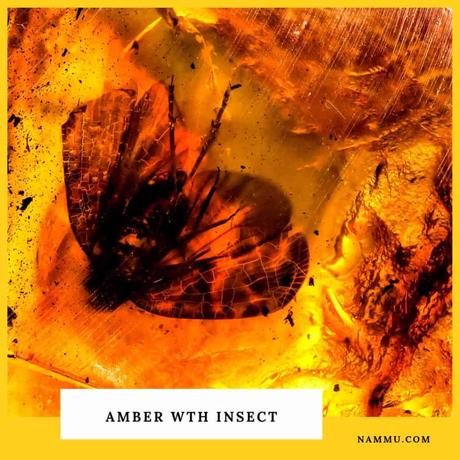
Amber with insects is the most extraordinaire and rare jewelry in existence! When buying amber with insects, you can be sure that noone ever will have a similar piece to yours! It is a unique creature of the Mother Earth that took millions of years to form, and even the richest people out there will not be able to replicate your piece, as even Nature itself, unfortunately, is not capable of producing amber anymore.
Among the whole bulk of collected amber on the planet, only around 5% contain inclusions. Taking into account that Baltic amber nowadays constitutes not less than 90% of the bulk of amber already collected throughout the world, there are super high chances that insect in your real amber was crawling the back of dinosaur at some point in its life.
Why is that? The answer is simple - Baltic amber (that covers 90% of all amber collected) was formed approximately in the middle of the Paleogene, about 65 - 55 million years ago in the same time period, when dinosaurs are believed to become extinct.
Do you know that price of Authentic Amber doubled in the last five years? So you can invest in Unique and Rare Amber with Insects Now using 5-Factor Authentication Procedure for Less than you think so Your children will thank you in 10 years.
Due to the highly limited supply of real amber from Baltic countries and ultrahigh demand on amber from China, the price of real piece of Baltic amber skyrocketed from 30$ to 70$ in the last five years. Therefore, the amber you purchase today will cost 140$ in 5 years and just imagine how much it will cost in 20 years from now.
This is even stronger apparent for amber with insects.
As we said, among the whole bulk of collected amber, only around 5% contain inclusions. Among them - 98.3% of fauna inclusions, flora inclusions account for 0.4% and 1.3% are reptiles, mollusks, minerals, air and water vesicles. So, there is such a small amount of real amber with insects left that probably in few years we will see it only in museums, displaying parts of dinosaurs and extinct insects.
Therefore, the amber with insect you purchase today will cost 140$ in 2 years. Imagine how much they will cost in 10...
Here you should be aware, that the fauna of the Paleogene, in particular insects, differs little from modern forms. This suggests that in the last 60-50 million years the evolution of insects experience some sort of recession. So, 99% of insects families found in Baltic amber are still exist on Earth and only 1% of insects trapped in amber are extinct. And even then, you will not be able to purchase amber with extinct insect it due to the high scientific importance this piece will have.
Amber with insects for scientists is an inexhaustible source of information. Thanks to inclusions preserved in amber, scientists now know what animals, insects and plant were inhabiting the Earth millions of years ago.
Even if fossils in amber are not useful for extracting dinosaur blood from for cloning purposes, despite what Jurassic Park may have you believe, they still preserve amazing snapshots of life millions of years ago. Amber is fossilized tree resin, a sticky, viscous substance secreted by plants in order to protect them from pests and predators. And because it is meant to protect a plant from predators, on occasion those organisms get stuck in the resin and frozen for millions of years, preserving fragile structures and unique instances of behavior paleontologists would have never seen otherwise.
These are just few example of the most incredible fossils found in amber in the last few years.
100-Million-Year-Old Insect Trapped in Amber Changes Evolution Order
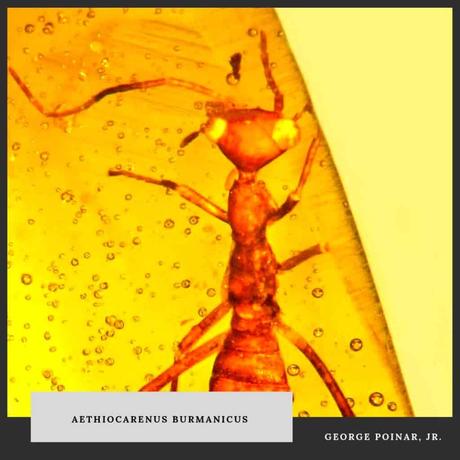
Do you know that new insect species are being discovered every month at least? Can you imagine how many more of them are there in the deep tropical forests waiting to be found? Yeah, might be a lot.
What is extremely rare, is to find an ancient insect trapped in amber that will completely change an order in which scientists think evolution of insects took place. That is what a discovery of 100-million-year-old wingless female insect trapped in an amber chunk actually did.
The fossilized tree resin with this insect was collected from mines in the Hukawng Valley of Myanmar. An exotic wingless female insect in mid-Cretaceous Myanmar amber was named Aethiocarenus burmanicus and the new order was called Aethiocarenodea order.
This insect has a number of features that just don't match those of any other insect species that scientists know. But the most curious thing about it is the unusual shape of its body that would have allowed the insect to turn its head 180 degrees and look behind itself, a trick that no modern insect is known to perform!
Not impressed yet? Check the next discovery out! But it is not for the faint of heart. I warned you.
100-Million-Years-Old Spider/Scorpion in Myanmar Amber
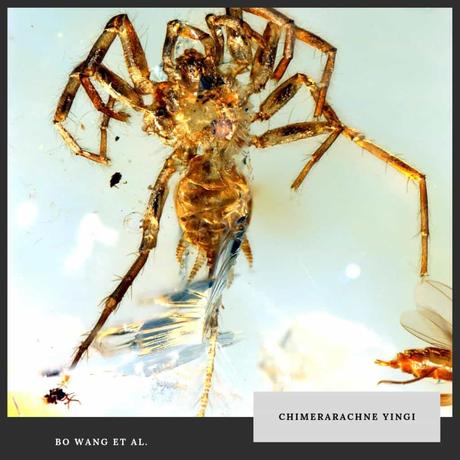
This one is like every person worst nightmare. After discovery, it was given a name Chimerarachne yingi.
Few years ago scientists discovered it in the Myanmar amber piece and revealed that this arachnid crawled around rain forests in what is now Southeast Asia more than 100 million years ago during the Cretaceous period - during the age of the dinosaurs.
Upon inspection, it was found that the creature's tail was longer that its body - meaning it was used as a sensory device to seek out prey or escape predators. Called a ' telson ', the tail is seen today in scorpions - but it has never been known before in a spider. This insect is just one of a kind as well as all other amber pieces with insects inside and that is what makes amber with insects so unique and high-valued.
Some scientists even say that it's possible that the creatures are still scuttling through the forests of Myanmar, where the specimen was discovered. So, help us God, because this spider is just too much.
100-Million-Years-Old Dinner Session Frozen in Amber
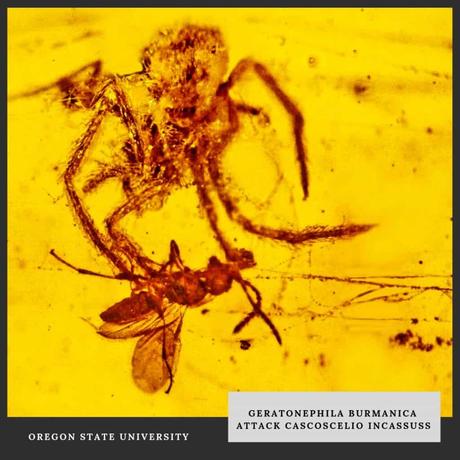
Can you imagine? Even something like this can be preserved in amber! Amber is the only mineral ever existing on Earth that was capable of doing that! And you can have it your hands for a very reasonable price. Isn't it a miracle?
Researchers have found trapped in amber a rare dinosaur-age scene of a spider attacking a wasp caught in its web. Well, to be honest, rare is understatement. This is the only fossil ever discovered that shows a spider attacking prey in its web.
The piece of amber, which contains 15 intact strands of spider silk, provides the first fossil evidence of such an assault, the researchers said. It was excavated in a Myanmar mine and dates back to the Early Cretaceous, between 97 million and 110 million years ago.
This juvenile spider was going to make a meal out of a tiny parasitic wasp, but never quite got to it. And this was a male wasp's worst nightmare, and it never ended. The wasp was watching the spider just as it was about to be attacked, when tree resin flowed over and captured both of them.
The amber chunk also contains the body of another male spider in the same web, which might make the fossil the oldest known evidence of social behavior in spiders, according to scientists.
Both the spider and wasp species are today extinct. But the type of wasp ( Cascoscelio incassus) belongs to a group that today is known to parasite spider eggs. So,the attack on the wasp by the bristly orb-weaver spider Geratonephila burmanica, might then be considered revenge.
It is like prehistoric Game of Thrones and only thanks to amber and its properties we were able to witness that. But that is still not the most interesting discovery.
100-Million-Year-Old Motherly Care of Offspring Preserved in Amber
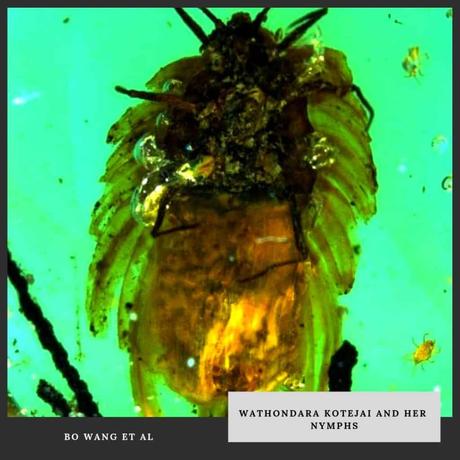
It may come as a surprise that insects, like humans, can care for their young. Scale insects are known to carry their eggs on their back and protect them through their nymph stage. This find of a female scale insect in Burmese amber with over 60 eggs on its back pushes the earliest evidence of insect brood-care to at least 100 million years ago. After this discovery, scientists said that 100-million-year-old care of offspring was unknown among insects until now.
Published in 2015 by Bo Wang and co-authors, this preserved scale insect is also a new species called Wathondara kotejai. Fossilized instances of animal behavior are extremely rare, making this amber fossil very unique.
Even her newly hatched babies, her nymphs, can be seen stuck to her in the amber. It is not often that animals with their brood are found in such incredibly well preserved state, which makes Wathondara a precious rarity in the fossil record.
100-Million-Year-Old Ancient Insects Camouflage Themselves in Dirt and Dead Bugs
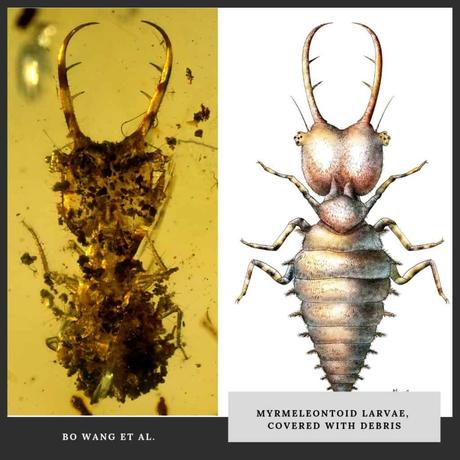
From disruptive patterns to mimicry, insects' ability to camouflage themselves from predators has played an important role in their evolutionary success.
Now experts have discovered the oldest known evidence of bugs using 'debris carrying' to stay hidden - a clever method still used by some larvae today.
Amber fossils reveal that insects concealed themselves by carrying grains of sand and soil, leaf fragments, wood fibers and even the exoskeletons of their prey, 100 million years ago.
Debris-carrying, a behavior of actively harvesting and carrying waste materials, is among the most fascinating and complex behaviors because it requires not only an ability to recognize, collect, and carry materials, but also evolutionary adaptations in related morphological characteristics, so an animal can blend in.
The fossil record, of such behavior is extremely scarce, with only a single Mesozoic example from Spanish amber known previously.
40-Million-Year-Old Meat-Eating Plants
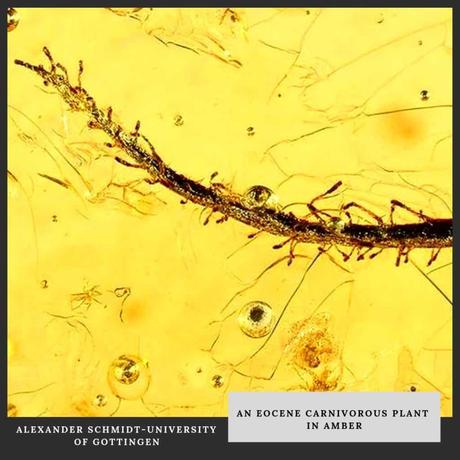
It is actually quite uncommon for large plant pieces to be trapped in amber. That is why it was so remarkable that in 2014, Eva-Maria Sedowski and co-authors were able to find and describe some of the earliest preserved remains of a carnivorous plant in approximately 40 million year old Baltic amber.
The sticky tentacles on this fossil plant resemble that of the modern plant family Roridulacea, which is currently restricted only to South Africa. This find reveals this group once had a much more widespread distribution.
80-Million-Year-Old Dinofuzz
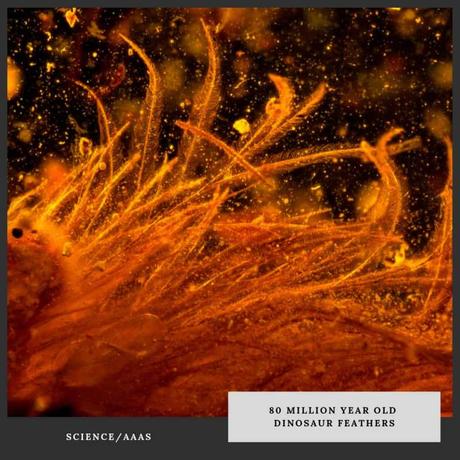
Perhaps the crowning glory of all amber fossils for dinosaur fans, in 2011, Ryan McKellar and co-authors described incredibly preserved protofeather inclusions in pieces of Cretaceous amber from Canada. Typically, paleontologists rely on feathers preserved flat in rock, but these do not preserve the three dimensional structure in as much details as is seen in the amber specimens.
Unbelievably, the colors of the feathers - gray, white, red, brown-are also preserved inside the amber pieces. These filament-like feathers appear to represent some of the earlier forms of feathers that dinosaurs, which are extremely rare in the fossil record.
44-Million-Year-Old Extinct Gekko in Baltic Amber
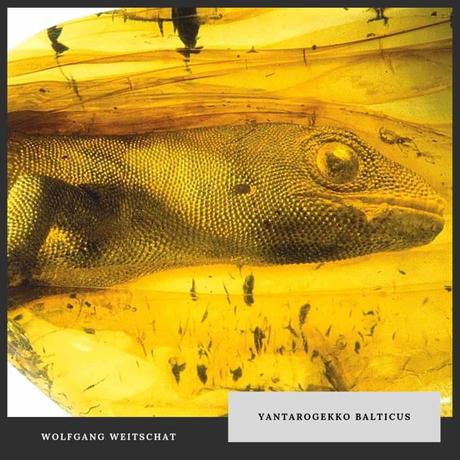
In 2006, the world was stunned by the announcement of a spectacularly preserved lizard in a piece of Baltic amber. This specimen, shown above, was named Yantarogekko balticus.
At the time, it was the oldest gecko known to science except for some odd, fragmentary bones. While the toes of Yantarogekkorevealed features not seen in any other lizard, it also had the expanded pads seen in modern geckos that enable their legendary climbing abilities.
Ten years later came news of much older specimens preserved in amber from Myanmar. This pushes back the fossil history of geckos to around 99 million years ago, a time when all the major groups of living lizards are thought to have evolved.
These Caribbean Anolis lizard fossils preserved in amber aren't just amazing to look at - they also make it possible for researchers to learn more about the evolution of lizard communities in deep time.
100-Million-Year-Old Flowers
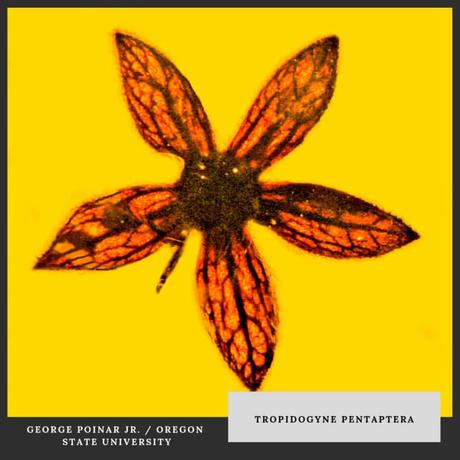
Last year, seven flowers have been found perfectly preserved in amber, from 100 million years ago. The flowers, discovered in Myanmar, were encased in amber in the Cretaceous period in what would have been a pine forest.
Following discovery is exceptional. Never before amber samples containing flowers were preserved that good. The amber preserved the floral parts so well that they look like they were just picked from the garden.
Scientists say: "Dinosaurs may have knocked the branches that dropped the flowers into resin deposits on the bark of an araucaria tree, which is thought to have produced the resin that fossilized into the amber."
100-Million-Year-Old Evidence of Sexual Reproduction in Flowers
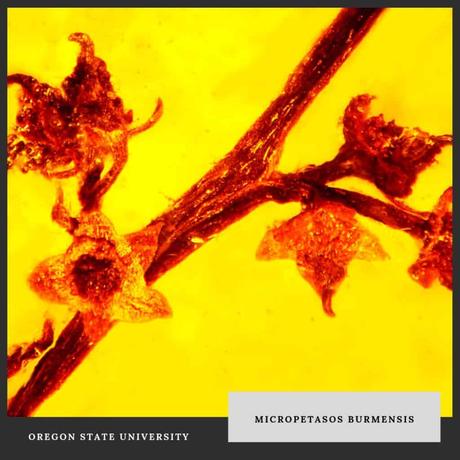
As we said before floral inclusion are contained in only around 1% of all amber found with inclusions what makes this discovery even more important.
In 2014, researchers from Oregon State University have revealed the earliest evidence of sexual reproduction in flower plants in a report published in the Journal of the Botanical Institute of Texas.
The evidence was found in a 100-million-year old piece of amber containing a bunch of 1 8 previously-undescribed flowers from the Cretaceous Period. Dubbed Micropetasos burmensis, the flowers were frozen in the process of making new seeds.
So, with all the fakes that flooded the market, how to be sure that the amber you buy is genuine and authentic?
As the biggest Amber Retailer in Europe, Nammu has developed a 5-factor Authentication Procedure specifically for our customers to make sure that every piece of amber we sell is authentic and real. With our procedure we can guarantee 99.99% chance that the amber you get from us was formed in times of pre-historic trees and, sometimes, even dinosaurs.
References: Forbes
